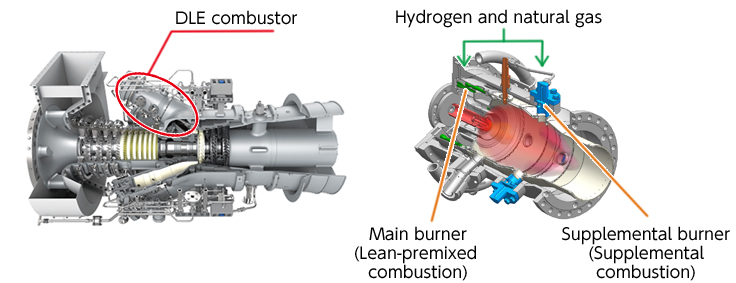Kawasaki Completes Lineup of Hydrogen-Mixed-Fuel DLE Combustors, Making All Kawasaki Gas Turbines for Cogeneration Systems Hydrogen-Compatible
Mar. 31, 2023
Tokyo, March 31, 2023 ― Kawasaki Heavy Industries, Ltd. announced today that it has begun the sale of hydrogen-mixed-fuel DLE*1 combustors for the 20-MW L20A and the 5-MW M5A gas turbines for cogeneration systems. With this launch, all Kawasaki gas turbine models for cogeneration systems can now be used with these DLE combustors, thereby achieving stable, low-NOx*2 mixed-fuel combustion using natural gas mixed with up to 30% hydrogen*3.
In these combustors, Kawasaki is utilizing a unique combination of lean-premixed combustion and supplemental combustion. In lean-premixed combustion, the fuel is mixed with air prior to combustion in order to eliminate localized high-temperature spots where most NOx emissions are produced. In supplemental combustion, additional fuel is injected after the lean-premixed combustion, allowing for variable power output with almost no NOx emissions, while keeping combustion in the main burner stable. By successfully applying this proprietary combustion technology to hydrogen-mixed-fuel combustion, Kawasaki has realized stable combustion while maintaining low NOx emissions on a par with those of natural gas combustion.
All models of Kawasaki’s natural-gas-fired gas turbines equipped with our DLE combustor can achieve hydrogen co-firing without modifications to the turbine itself. Only the addition of equipment such as a hydrogen compressor and fuel-mixing system is necessary, with no need to replace other components of the current system. This feature enables operators to continue using existing gas turbine engines with proven reliability while harnessing the power of hydrogen energy. It is estimated that CO2 emissions can be reduced by 600,000 tons per year worldwide if all natural-gas-fired turbines for which Kawasaki delivers DLE combustors are modified to the type capable of hydrogen co-firing.

To accommodate diverse customer needs for hydrogen utilization, Kawasaki has been commercializing combustors fitted for various types of gas turbine power generation systems ― from hydrogen co-firing to fully hydrogen-fired. It is also aiming to develop more products to expand its portfolio. These hydrogen power generation technologies will be key in expanding the use of CO2-free hydrogen and by-product hydrogen.
Foreseeing a significant increase in the use of hydrogen energy in the future, which will play a vital role in achieving a decarbonized society, Kawasaki is developing a range of technologies for the hydrogen supply chain (production, transportation, storage, and utilization). Hydrogen gas turbines are one of the key elements in the “utilization” stage that significantly reduce carbon emissions in Japan’s power generation sector, which produces about 40% of the nation’s CO2 emissions. Pursuant to its Mission Statement, “Kawasaki, working as one for the good of the planet,” the Company will continue to develop gas turbine combustion technologies that encourage greater utilization of hydrogen.
Specifications of cogeneration systems equipped with hydrogen-mixed-fuel DLE combustors
| Model | M1A-17D | M5A-01D | M7A-03D | L20A-01D | L30A-01D | |
|---|---|---|---|---|---|---|
| Hydrogen co-firing ratio (volume %) | 0 – 30*3 | |||||
| Power generation output (kW) | 1,777 | 4,710 | 7,650 | 17,610 | 32,260 | |
| Fuel consumption(m3N/h) | Natural gas | 509 | 1,157 | 1,835 | 4,172 | 6,494 |
| Hydrogen | 219 | 497 | 787 | 1,789 | 2,783 | |
| Steam output (t/h) | 5.1 | 10.9 | 17.2 | 38.7 | 53.5 | |
| NOx emissions (ppm) (O2=15%) |
15 | 20 | 15 | 25 | 25 | |
| Volume of CO2 generated (t/h) | 1.2 | 2.7 | 4.2 | 9.6 | 14.9 | |
| Power generation efficiency (%) | 27.7 | 32.4 | 33.2 | 33.6 | 39.5 | |
| Total thermal efficiency (%) | 83.7 | 84.8 | 85.5 | 85.3 | 85.4 | |
Conditions: Inlet air temperature: 15°C; atmospheric pressure: 101.3 kPa (elevation=0 m); inlet air pressure loss: Standard; LHV* of fuel: natural gas 40.629 MJ/Nm3 hydrogen 10.789 MJ/Nm3
| * | LHV=Lower Heating Valve |
Boiler: Steam pressure 0.78 MPaG water supply temperature 60℃
CO2 emissions coefficients: Natural gas 2.29 t-CO2/1,000 Nm3 Hydrogen 0t-CO2/1,000 Nm3
| *1 | Dry Low Emission, a method of reducing NOx emission volumes by keeping combustion temperatures low without relying on water and steam injection. |
| *2 | Nitrogen oxides. A category of oxides formed through the joining of nitrogen and oxygen in the air as a result of high-temperature combustion. NOx are causal factors in photochemical smog and acid rain. NOx emission amounts are limited by the Air Pollution Control Act and local government ordinances. |
| *3 | It is expected that 30% hydrogen-mixed-fuel combustion for the M5A will be available in fiscal 2023. |
For more information, see “Hydrogen gas turbine development roadmap” at:
https://global.kawasaki.com/en/energy/pdf/20220915_hydrogen-introduction_e.pdf![]()
Contact
If you need more information about our business,
please feel free to contact us.





